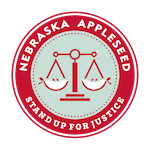***For Immediate Release***
August 1, 2018
Contact, Jeff Sheldon
Communications Director, Nebraska Appleseed
Office: (402) 438-8853
Mobile: (402) 840-7289
Email: jsheldon@neappleseed.org
National Survey Finds 12 Percent of Nebraska Households Struggle to Afford Food
New Data Underscores Need to Protect and Improve Federal Nutrition Programs
LINCOLN — In every part of the United States, a large number of households are experiencing food hardship — the inability to afford enough food for themselves and their families — including 1 in 8 Nebraskans (12.8 percent) according to a new report by the Food Research and Action Center (FRAC).
The report, “How Hungry is America?” reveals that, after several years of decline, the national food hardship rate for all households increased from 15.1 percent in 2016 to 15.7 percent in 2017. The report contains national and state data, plus results of 100 of the country’s largest Metropolitan Statistical Areas (MSAs), including Omaha/Council Bluffs.
Nebraska also had one of the nation’s highest disparities in food hardship between households with children (16.2 percent) and households without children (10.9 percent).
“This data show Nebraska continues to fight an ongoing battle against hunger that is preventing too many families from getting ahead,” Nebraska Appleseed Economic Justice Program Director James Goddard said. “It does great harm to Nebraska’s families and workforce when so many children, seniors, veterans, working adults and people with disabilities are struggling to make ends meet.
“We must do more to make sure all Nebraskans have the means to put food on the table. This includes fair wages for hard-working people, strong education and skills programs for those that need them, and investments in the work-support programs like the Supplemental Nutrition Assistance Program that helps families and children get the meals they need and also pay for rent, utilities, and other necessities.”
FRAC President Jim Weill said that food hardship remains a serious national problem that requires a serious national policy response.
“Too many people in every region, state, and community have been left behind in the economic recovery from the Great Recession, and are still struggling to put food on the table,” Weill said.
Although the nation’s unemployment rate continued to fall in 2017, wages were largely stagnant, and Congress and most states failed to provide needed initiatives to boost both wages and public programs for struggling individuals and families. In addition, the Trump Administration and the U.S. House of Representatives have attempted to cut vital programs such as the Supplemental Nutrition Assistance Program (SNAP), school meals, and Medicaid, which will only worsen food hardship in Nebraska.
“The high rates of food hardship underscore the need for Congress to pass a Farm Bill that protects and strengthens SNAP,” added Weill. “Otherwise, we will see worse health and hunger for struggling children, seniors, working families, and others across the country.”
About the report
How Hungry is America? contains data for the nation for 2017 and for every state and the District of Columbia, and 108 metropolitan statistical areas (MSA) for 2016–2017. The data were gathered as part of the Gallup-Sharecare Well-Being Index project, which has been interviewing hundreds of households daily since January 2008.
FRAC analyzed responses to the question: “Have there been times in the past twelve months when you did not have enough money to buy food that you or your family needed?” A “yes” answer to this question is considered to signal that the household experienced food hardship. FRAC uses the phrase “food hardship” to avoid confusion with the annual Census Bureau/U.S. Department of Agriculture survey and analysis that produces “food insecurity” numbers, but the concepts are comparable.
